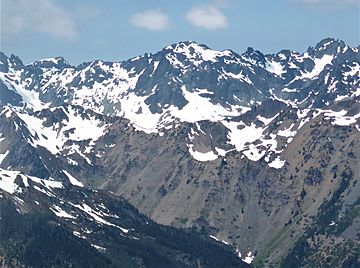Martin Peak (Olympic Mountains) facts for kids
Quick facts for kids Martin Peak |
|
|---|---|

Martin Peak centered, from east.
(Mt. Johnson to right) |
|
| Highest point | |
| Elevation | 7,638 ft (2,328 m) |
| Prominence | 238 ft (73 m) |
| Isolation | 0.54 mi (0.87 km) |
| Parent peak | Mount Johnson |
| Geography | |
| Location | Olympic National Park Jefferson County, Washington, US |
| Parent range | Olympic Mountains |
| Topo map | USGS Mount Deception |
| Geology | |
| Age of rock | Eocene |
| Climbing | |
| First ascent | 1940 |
| Easiest route | class 3 scramble |
Martin Peak is a tall mountain located in the Olympic Mountains in Washington state. It stands in Jefferson County and is part of the beautiful Olympic National Park.
This peak reaches a height of 7,638 feet (2,328 m). This makes it the seventh-highest peak in the entire Olympic Mountains range. It is also the second-highest peak in a smaller group of mountains called The Needles. Martin Peak's closest taller neighbor is Mount Johnson, which is about 0.53 mi (0.85 km) away to the north-northwest.
Rain and snowmelt from Martin Peak flow in two main directions. To the west, the water goes into the upper parts of the Gray Wolf River. To the east, it flows into Royal Creek. Both of these rivers eventually join the Dungeness River. Martin Peak got its name from George W. Martin (1901–1970). He was one of the first people to climb the mountain in 1940, along with Elvin Johnson.
Weather Around Martin Peak
Martin Peak is in a marine west coast climate zone. This means it gets a lot of weather from the Pacific Ocean. Most weather systems move from the Pacific Ocean towards the northeast. When these weather systems hit the tall Olympic Mountains, they are forced to rise. This causes them to drop their moisture as rain or snow. This process is called Orographic lift.
Because of this, the Olympic Mountains get a lot of rain and snow, especially in winter. Winters are often cloudy. However, in summer, high-pressure systems over the Pacific Ocean bring clear skies. This means there is often little to no cloud cover during the summer months.
The snow here tends to be wet and heavy due to the ocean's influence. This can sometimes lead to avalanche danger. But Martin Peak is in a special area called a rain shadow. This means it gets less rain and snow than other parts of the Olympic Mountains, like Mount Olympus. The best time to visit or climb Martin Peak is usually from July through September. The weather is most favorable then.
How Martin Peak Was Formed
The Olympic Mountains, including Martin Peak, are made of special kinds of rock. These rocks were formed from pieces of older rocks and parts of the ocean floor. They are mostly Eocene sandstone, a type of rock formed from sand, and basaltic oceanic crust.
The mountains got their shape during the Pleistocene era, also known as the Ice Age. During this time, huge sheets of ice called glaciers moved across the land many times. These glaciers carved out valleys and shaped the peaks as they advanced and then melted away. This process of erosion created the beautiful mountain landscape we see today.
Images for kids
-
East aspect. {Sundial to right)
-
Martin Peak (right) seen with Gilhooley Tower and Mt. Johnson







